When is the best time to send emails?
If you send your email during peak hours, it will likely get lost in a stack of other emails that went out at the same time as yours.
Undoubtedly, sending emails is a potent tool for businesses to connect with their audience, generate leads, and boost sales., but the million-dollar question is when is the ideal time to send them?
In this article, we will embark on an exciting journey to uncover the secrets of perfect timing for email success. Prepare as we explore data and strategic insights to reveal the best moments to send your emails. However, it’s important to note that what works for one business may not work for another. That’s why we’ll also introduce innovative methods to discover the ideal email-sending times explicitly tailored to your business.
Get ready to increase your open rates, boost clicks, and witness your sales soar.
Email Metrics
Email metrics are measurements used to assess the performance and effectiveness of email marketing campaigns. These metrics provide insights into how recipients engage with the emails and help evaluate the campaign’s success. In this section, we will define the most critical email metrics:
Open Rate: This represents the percentage of recipients who opened the email, giving us insights into the effectiveness of the subject line and sender’s name in capturing recipients’ attention.
Click-Through Rate (CTR): Refers to the number of people who open a link or image in an email. This number will always be smaller than the total number of emails opened since some people will open your email but abandon it without engaging with it any further.
Conversion Rate: The percentage of recipients who completed a desired action, such as purchasing or filling out a form. It indicates the overall effectiveness of the email campaign in achieving its goals.
This article will show you how to boost these email metrics.
Let’s Dive In!
What Is the Best Time to Send an Email?
There is an abundance of data and statistics available that can help determine the optimal day for sending business emails.
Numerous studies have consistently indicated that Tuesdays and Thursdays are the most favorable days for sending business emails. Additionally, when considering the specific hour of the day, it has been observed that transitional periods tend to yield the best results.
Sending emails at 8 AM can effectively capture the attention of individuals who check their emails first thing in the morning. At 1 PM, which falls during or after the lunch break, recipients are likelier to engage with the content. Sending emails at 4 PM offers a potential pick-me-up as people face the final hour of the workday. Lastly, sending emails at 6 PM, during or after the evening commute, can yield positive results.
During these periods, people tend to be more active online. However, there is no consensus regarding the specific day or time for sending emails.
In reality, these time slots don’t always yield optimal results. Each email list comprises individuals with unique habits and preferences. Therefore, the most suitable sending time for your business may differ from that of others.
While these marketing standards provide a solid foundation, there are no strict rules for email sending.
Instead, it is crucial to understand your audience and determine what works best for them.
Nevertheless, knowing the global standards for ideal posting times can be a helpful starting point. From there, you can experiment, analyze, and adjust your email schedule to find the perfect timing.
Here are four email marketing organizations that have tracked the most effective times for sending emails.
Omnisend
To learn about the best time to send an email, Omnisend analyzed over 2 billion email marketing campaigns sent using their platform.
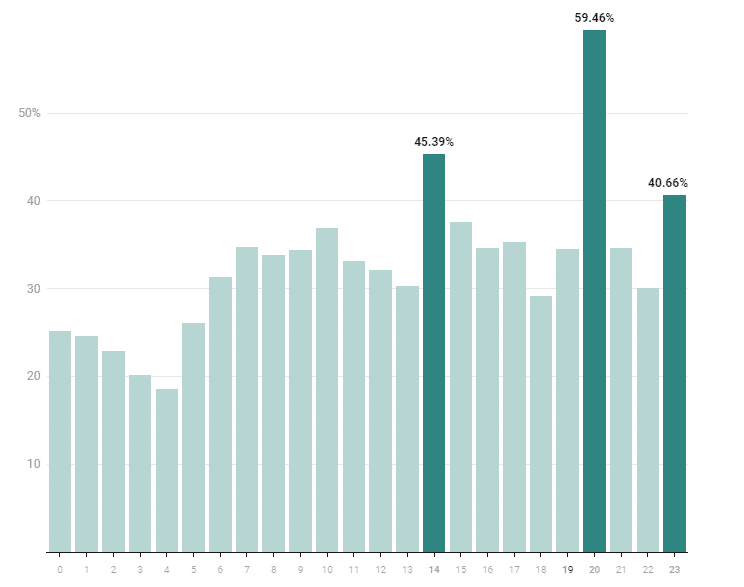
When it comes to open rates, there are a few unexpected findings. Surprisingly, the highest open rate, a remarkable 59%, occurs at 8 PM. Following that, a more intuitive time, 2 PM, boasts a 45% open rate.
Moving into the late evening, we observe a 40% open rate at 11 PM.
Before jumping to any conclusions, let’s examine the data concerning clickthrough rates:
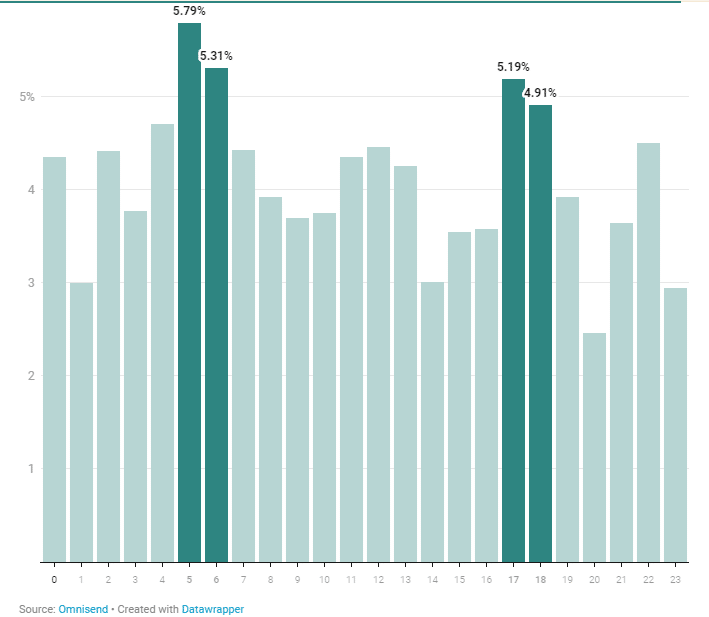
Here, we’ve got a few more surprises. We have two sets available: 5 AM and 6 AM and 5 PM and 6 PM.
In the context of the evening, it is logical that people tend to engage with relevant emails as they read and click on them after work.
Regarding the high click rates observed between 5 AM and 6 AM, this can be attributed to minimal competition. Individuals awake during that time tend to check and click on emails since their inbox isn’t flooded with new messages.
In general, when analyzing both open and click rates, we observe that the traditional early morning hours of 6 AM to 11 AM yield favorable results regarding opens and clicks. Additionally, after lunch, we observe even higher open rates compared to the morning; however, click rates do experience a slight decline.
Brevo
Brevo’s research uncovered two good times to send emails: 10 AM and between 3 PM and 4 PM.
These times may not be surprising. At 10 AM, most people are already at work and trying to get some things accomplished, eventually checking their email inbox and going through their unread messages.
Between the hours of 3 PM and 4 PM, these people have likely finished lunch or are gearing up to leave work soon. They check their email once again before they’re done for the day.
Brevo also found that click-through rates were high through 6 PM and, sometimes, even 7 PM. During this timeframe, people may commute home from work or are already at home checking their emails.
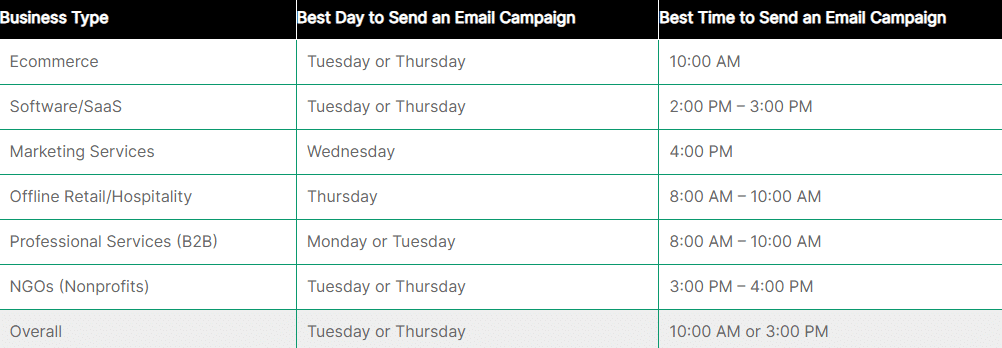
Brevo broke down its findings regarding the best time to send an email by industry.
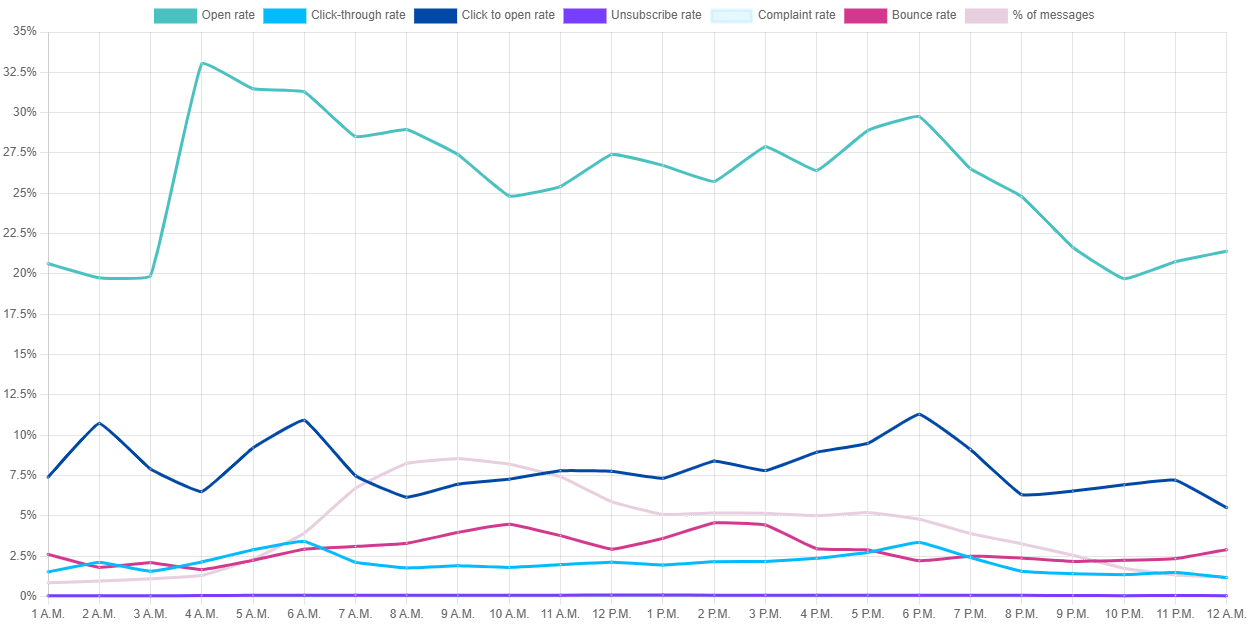
GetResponse’s 2023 email analysis shows two recommended time slots to consider for better email engagement. The first is early in the morning (4–6 AM), and the second is later in the afternoon (5–7 PM).
To maximize opens and clicks, GetResponse recommends sending your emails right before your recipients wake up or towards the end of their workday. During these periods, inboxes tend to be less congested, significantly improving your chances of capturing your audience’s attention.
According to Moosend’s analysis, Thursday had the highest open rate among weekdays, making it the most favorable day. Tuesday followed closely as the second-best day. On the other hand, Saturday experienced the lowest average open rate.
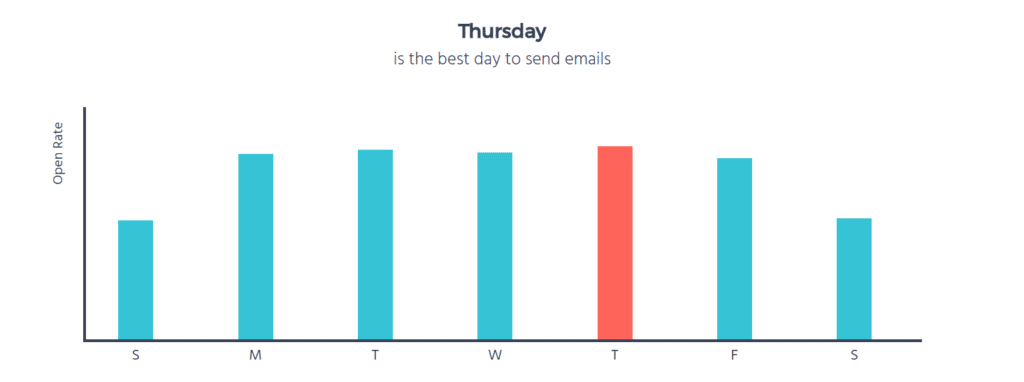
The optimal time for email delivery was between 8 AM and 9 AM. However, open rates began to decline after 6 PM.

So, Thursday 8–9 AM is the best time to send an email campaign, according to Moonsend analysis.
Key Takeaways
Consider these studies a foundation, and rely on your data to verify your decisions.
Although research suggests that customers tend to open emails most frequently in the morning and evening, sending emails in the afternoon could still be beneficial in achieving your specific objectives. Sometimes, it may be strategic to schedule emails for the afternoon or early evening when individuals are wrapping up work or checking emails before winding down for the day.
The key is experimentation. Test various sending times to determine when your business experiences the highest open rates, click-through rates, and conversions.
Factors to Consider When Choosing a Time to Send Emails
Here are several factors to consider to optimize the timing of your emails and achieve maximum engagement and response rates:
Target Audience: Understanding your target audience is crucial when determining the ideal time to send emails. Consider their demographics, such as age, location, and occupation, as these factors can influence their email habits. For example, professionals may be more responsive during business hours, while individuals with different time zones may require adjusted sending times.
Industry and Nature of Business: Consider the industry in which you operate and the nature of your business. Certain industries may have specific peak periods or seasons that affect customer engagement. For instance, a retail company might find higher engagement rates during weekends or holidays, while B2B companies may have better response rates during weekdays when professionals are more active.
Analyze Past Data: Analyze your email marketing data to gain insights into past performance. Examine metrics like open rates, click-through rates, and conversion rates for different time slots. Identify patterns and trends to understand when your audience will likely engage with your emails. Use this data as a starting point for determining the optimal sending time.
A/B Testing: Conduct A/B testing by dividing your email list into two groups and sending the same email at different times. Measure the performance of each group to determine which time slot yields better results. Repeat this testing process with variations in timing until you find the optimal time that consistently generates the desired outcomes.
Mobile Device Usage: Consider the prevalence of mobile device usage among your target audience. With the rise of smartphones, many people access their emails on the go. Optimize your timing to align with peak mobile usages periods, such as early mornings, lunch breaks, or evenings when people are likely to check their emails on their smartphones.
By understanding and leveraging these factors, you can increase the effectiveness of your email campaigns, improve engagement rates, and ultimately achieve your desired results.
Remember, finding the perfect timing may require experimentation and continuous analysis. Regularly observe and adjust your email-sending schedule to guarantee consistent outreach to your audience during the most favorable moments.
How to Get Higher Email Open Rates
To improve your email open rates, you can implement the following strategies:
Craft compelling subject lines: I can’t stress enough the importance of a good subject line!
As your best first-impression weapon, creating a straightforward subject line will boost your open rate. Just think of your inbox. Would you ever click on something that looks spammy? Definitely not!
So, when you create those subject lines for your audience, ensure a clear message that spam filters won’t catch.
Here are the best ways to nail your subject lines for better open rates. Follow these guidelines: Keep them concise and focused, emphasize immediate value, use relevant emojis to capture attention, and incorporate a sense of urgency.
By implementing these strategies, you can create subject lines that stand out in your subscribers’ inboxes.
Personalize your emails: Address recipients by their names and segment your email lists to send targeted, relevant content. Personalization can make your emails more appealing and increase the chances of them being opened.
Optimize for mobile devices: Ensure your emails are mobile-friendly and responsive. Many people check emails on their mobile devices, so optimizing your emails for smaller screens is crucial for improving open rates.
Experiment with send times: Test different send times to determine when your target audience will most likely open emails. Consider time zones and the nature of your audience’s routines to optimize the timing of your email campaigns.
Provide valuable and relevant content: Deliver useful, informative, or entertaining content to your subscribers. Tailor your messages to their interests and needs. When recipients anticipate valuable content, they are more likely to open your emails.
Use a recognizable sender name and address: Use a sender name and email address that recipients will recognize and trust. Avoid generic or unfamiliar sender details that may be perceived as spam.
Avoid spam triggers: Refrain from using spam-triggering words, excessive punctuation, or misleading information in your subject lines and email content. Be transparent and genuine in your communication to avoid triggering spam filters.
How Long Should Your Subject Line Be
Below we’re looking at the relationship between the email subject line length and the average open rates they scored.
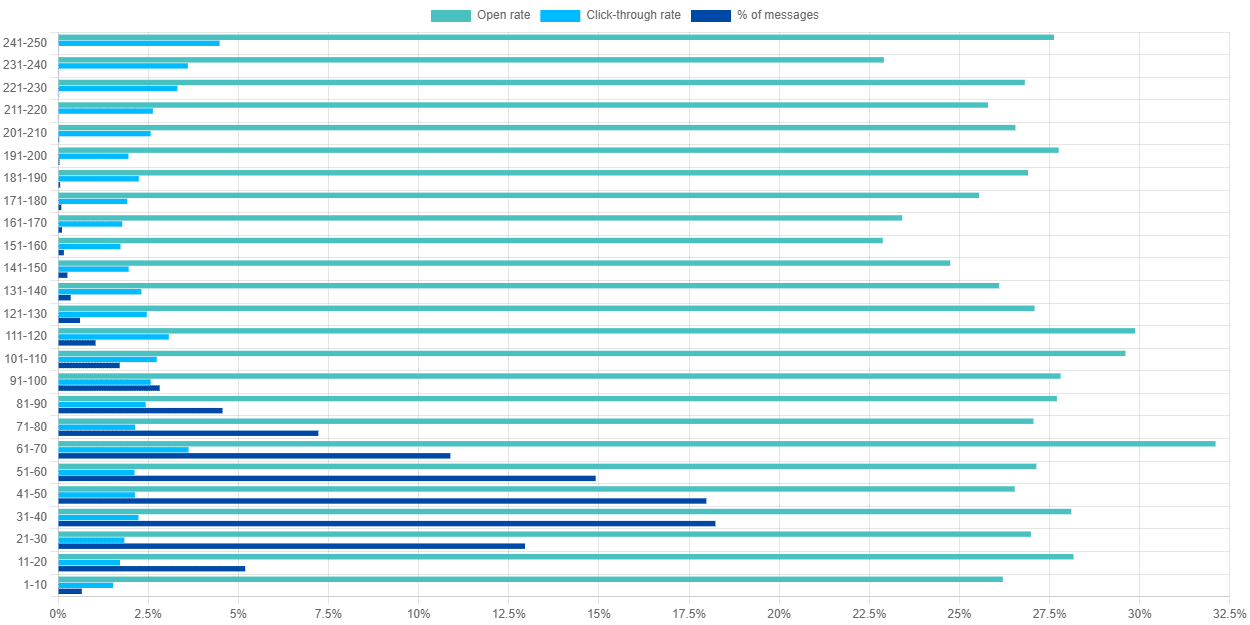
According to GetResponse’s 2023 email analysis, keeping subject lines short has always been recommended. This is because email clients often trim subject lines to fit on different device screens.
The analysis data indicates that subject lines ranging from 61 to 70 characters have performed exceptionally well.
Interestingly, longer subject lines tend to generate higher open and click rates. However, this doesn’t necessarily mean you should make your subject lines longer.
To find the optimal length, conduct A/B testing of subject lines within the displayed range on different devices. It’s important not to worry too much if you exceed the 60-character limit; your email campaign will still be effective.
Ultimately, the key is to give subscribers an enticing glimpse of what’s inside your email. Remember, your sender name and preheader text also play a role in capturing attention.
In most cases, it’s not solely about the length of the subject line but rather the message it conveys. When the content is relevant to your audience, crafting a subject line that yields a high open rate becomes easier.
Conclusion
Timing is a critical factor in the success of your email marketing campaigns. By understanding your audience, experimenting, and staying informed about industry trends, you can unlock the power of strategic timing to boost open rates, increase clicks, and ultimately drive sales.
Email marketing is a long-term play. You must cultivate strong relationships with your audience to achieve a high return on investment (ROI). This involves consistently delivering value and fulfilling your promises.
Remember that determining the optimal time to send emails is an ongoing process. Continuously monitor and adjust your strategy to ensure sustained success in your email marketing endeavors.